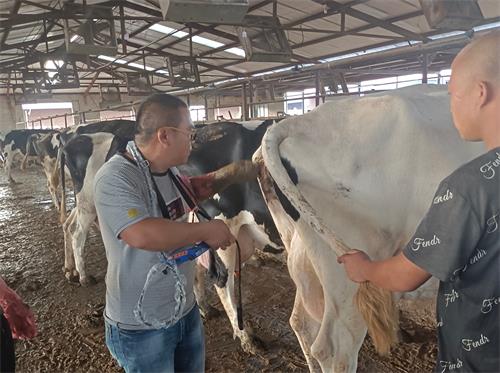Efficient reproductive management is vital for profitable beef cattle operations. From timely breeding to accurate pregnancy detection, every step in the reproduction cycle affects productivity and profitability. As global demand for beef continues to rise, producers are increasingly turning to Veterinary ultrasound as a key tool to enhance reproductive efficiency. While ultrasound is well-known in modern animal husbandry, its effectiveness heavily depends on how it's used — and that begins with adopting the right protocol for your specific breed.
Understanding the Role of Ultrasound in Beef Cattle Reproduction
Ultrasound imaging, a non-invasive diagnostic technique, allows for real-time visualization of reproductive structures in cows and heifers. It helps detect pregnancy as early as 26–30 days after breeding, identify ovarian structures, diagnose reproductive tract abnormalities, and even determine fetal sex.
However, not all cattle breeds respond identically to reproductive technologies. Factors such as body condition, breed-specific anatomy, and genetic variation can influence how ultrasound is best applied. That’s where breed-specific ultrasound protocols come into play.
Why Breed Matters in Ultrasound Protocols
Beef cattle breeds like Angus, Hereford, Simmental, and Brahman differ significantly in their reproductive anatomy, fat distribution, and estrous behavior. For instance, Bos indicus breeds (like Brahman) typically have smaller reproductive tracts and longer intervals between ovulations compared to Bos taurus breeds (like Angus or Hereford). These differences necessitate tailored scanning approaches to improve accuracy and minimize stress.
Adapting ultrasound protocols to the physiological traits of a specific breed can result in:
Faster and more accurate pregnancy diagnosis
Better ovulation timing for artificial insemination (AI)
Reduced handling stress and labor time
Improved conception and calving rates
Early Pregnancy Diagnosis: Adjusting for Breed Differences
Early pregnancy detection is key to maintaining tight calving intervals. Yet the timing and technique used for scanning can vary by breed. For example, British breeds like Angus or Hereford often allow for transrectal ultrasound scanning at 28 days post-breeding with clear imaging. In contrast, Zebu-influenced breeds like Brahman may require slightly later scanning (30–35 days) due to their smaller uterine size and thicker rectal walls, which can reduce image clarity at earlier stages.
Operators also report that Simmental and Charolais breeds tend to accumulate more subcutaneous and visceral fat, which can obscure transabdominal scans later in gestation. Choosing the right transducer frequency (typically 5.0–7.5 MHz for rectal, 3.5 MHz for abdominal) and positioning is critical in such cases.

Follicular Monitoring and Timed AI: Getting It Right
One of the greatest strengths of ultrasound is its ability to monitor ovarian follicles and support precise estrus synchronization programs. This is particularly beneficial in breeds with less visible estrus signs, such as Simmental or Bos indicus types.
By scanning ovaries to track dominant follicle growth, producers can better schedule artificial insemination, improving the success rate of timed AI (TAI) protocols. Research suggests that ultrasound-guided synchronization increases AI conception rates by up to 15%, especially in herds with mixed or hard-to-observe breeds.
Breed-specific tips for TAI using ultrasound:
Bos taurus breeds: Respond well to standard protocols like the CO-Synch + CIDR method; ultrasound aids in verifying follicle readiness pre-insemination.
Bos indicus breeds: Often benefit from longer progestin treatments and additional GnRH shots; ultrasound confirms ovulation status more accurately than visual heat detection.
Improving Calving Distribution and Herd Management
Efficient ultrasound use can reduce the number of open cows, allowing for earlier re-breeding or culling decisions. This directly affects the herd’s calving distribution, pushing more cows to calve in the first 21 days of the season — a benchmark for profitability in commercial beef production.
Moreover, precise pregnancy staging with ultrasound lets ranchers group cows by trimester, adjust feeding protocols, and allocate labor more effectively. This is especially valuable in operations with multiple breeds, where variation in gestation length can lead to miscalculations in nutrition and labor scheduling.

Practical Tips for Implementing Breed-Specific Protocols
Train Staff or Hire Skilled Operators
Using ultrasound effectively requires trained personnel who understand both the technology and breed-specific reproductive nuances. Consider veterinary technicians certified in bovine ultrasonography or veterinarians with experience across breeds.Use the Right Equipment and Settings
Match your ultrasound unit and probes to the breed’s body type. High-frequency linear probes are ideal for leaner breeds and early pregnancy, while convex or lower-frequency probes work better in larger or fat-rich animals.Record and Analyze Data
Breed-specific reproductive records help refine protocols year after year. Track conception rates, scan clarity, and calving intervals across different breeds in your herd.Integrate with Other Technologies
Combining ultrasound with estrus detection aids, synchronization drugs, and herd management software can significantly enhance decision-making and reproductive outcomes.Consult Veterinarians Regularly
Work with a veterinarian familiar with your breed types and production goals. Their insight is critical when modifying scanning schedules, interpreting ambiguous images, or managing unexpected reproductive issues.
Conclusion: One Size Doesn’t Fit All
While ultrasound is a universally powerful tool, maximizing its benefits requires a breed-sensitive approach. Understanding the anatomical and physiological distinctions between beef cattle breeds allows producers to tailor their scanning practices for better accuracy, higher conception rates, and more streamlined herd management. Whether you're managing a purebred Angus herd or a mixed-breed operation, the right ultrasound protocol can elevate your reproductive efficiency and your bottom line.
Sources and References:
“Ultrasound Reproductive Technologies in Beef Cattle” – Penn State Extension. https://extension.psu.edu/ultrasound-reproductive-technologies-in-beef-cattle
“Beef Cattle Reproduction” – Oklahoma State University Animal Science. https://extension.okstate.edu/fact-sheets/beef-cattle-reproduction.html
“The Use of Ultrasound in Reproductive Management of Cattle” – University of Missouri Extension. https://extension.missouri.edu/publications/g2025
“Estrus Synchronization for AI in Beef Cattle” – Iowa State University Extension. https://www.extension.iastate.edu/dairyteam/estrus-synchronization
tags:


